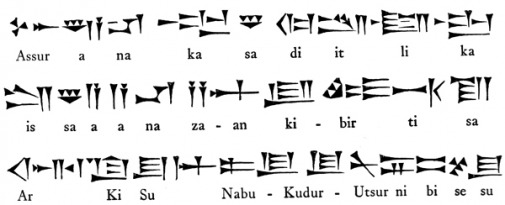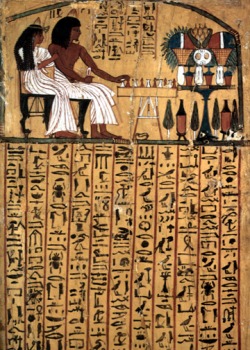Earliest Form of Writing: Cuneiform
The earliest writing in Mesopotamia was a picture writing invented by the Sumerians, who wrote on clay tablets using long reeds, called cuneiform. The word cuneiform is derived from two Latin words: cuneus , which means "wedge," and forma , which means "shape." This picture language, similar to but more abstract than Egyptian hieroglyphics, eventually developed into a syllabic alphabet under the Assyrians and Babylonians.
The ‘wedges and hooks’ of Sumerian writings are the original forms of cuneiform and are represented in Sumerian entire words (this is called ideographic and the word symbols are called ideograms, which means "concept writing"); the Semites who adopted this writing, however, spoke an entirely different language. In order to adapt this foreign writing to a Semitic language, the Akkadians converted it in part to a syllabic writing system; individual signs represent entire syllables. As an ideogram, this cuneiform also stands for the Assyrian word irsitu , or "earth." So reading cuneiform involves mastering a large syllabic alphabet as well as a large number of ideograms, many of them identical to syllable symbols. This complicated writing system dominated Mesopotamia until the century before the birth of Christ; the Persians greatly simplified cuneiform until it represented something closer to an alphabet.
As with all cultures, writing greatly changed Mesopotamia’s social structure and the civilization's relationship to its own history. Writing allowed laws to be written, and stories to be passed down, not only by word of mouth, but with a definite story to be told true to character for each generation to come.
The ‘wedges and hooks’ of Sumerian writings are the original forms of cuneiform and are represented in Sumerian entire words (this is called ideographic and the word symbols are called ideograms, which means "concept writing"); the Semites who adopted this writing, however, spoke an entirely different language. In order to adapt this foreign writing to a Semitic language, the Akkadians converted it in part to a syllabic writing system; individual signs represent entire syllables. As an ideogram, this cuneiform also stands for the Assyrian word irsitu , or "earth." So reading cuneiform involves mastering a large syllabic alphabet as well as a large number of ideograms, many of them identical to syllable symbols. This complicated writing system dominated Mesopotamia until the century before the birth of Christ; the Persians greatly simplified cuneiform until it represented something closer to an alphabet.
As with all cultures, writing greatly changed Mesopotamia’s social structure and the civilization's relationship to its own history. Writing allowed laws to be written, and stories to be passed down, not only by word of mouth, but with a definite story to be told true to character for each generation to come.
Hieroglyphics
One of the first writings was hieroglyphics. Hieroglyphics was created and used by the ancient Egyptians. This written language consists of more than 2,000 characters. Hieroglyphics actually means "the words of god", and the only people in Ancient Egypt that wrote these confusing characters were priests. The priests wrote on papyrus. Papyrus was considered to be the first paper because most civilizations wrote either on stone or clay tablets. (The Chinese were the first ones to use papyrus even before the Ancient Egyptians) Furthermore, if it wasn't for Napoleon Bonaparte's invasion into Egypt, we probably wouldn't have found the Rosetta Stone. The Rosetta Stone is one of the most important documents there are about Ancient Egypt because it deciphered the unknown language.
Latin
Latin is a member of the broad family of Italic languages. Its alphabet, emerged from the Old Italic alphabets. Historical Latin came from the prehistoric language of the Latium region, specifically around the River Tiber, where Roman civilization first developed. The Italic languages form a centum subfamily of the Indo-European language family. They include the Romance languages (among others, French, Catalan, Italian, Spanish, Portuguese, Romanian), and a number of extinct languages.
How and when Latin came to be spoken are questions that have long been debated. Various influences on Latin of Celtic dialects in northern Italy, the non-Indo-European Etruscan language in Central Italy, and the Greek of southern Italy have been detected, but when these influences entered the native Latin is not known for certain.
How and when Latin came to be spoken are questions that have long been debated. Various influences on Latin of Celtic dialects in northern Italy, the non-Indo-European Etruscan language in Central Italy, and the Greek of southern Italy have been detected, but when these influences entered the native Latin is not known for certain.



